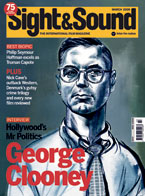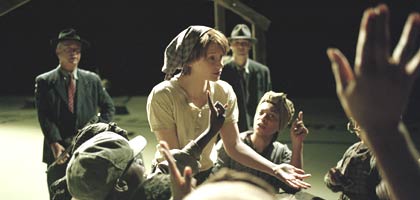
Manderlay
Denmark/ Sweden/ France/ UK/ Germany/ Netherlands/ Finland/ Italy 2005

Reviewed by Ryan Gilbey
Synopsis
Our synopses give away the plot in full, including surprise twists.
America, 1933. After leaving the town of Dogville, Grace and her gangster father head south to Alabama, where they find slavery thriving at the Manderlay cotton plantation. Her father moves on, but Grace stays at the plantation and oversees the slaves' emancipation, teaching them successfully about democracy. A dust storm ruins most of the cotton, but this drives the community to work harder. Grace rations the food so that Claire, a child sick with pneumonia, will have enough to eat. The girl dies when an old woman called Wilma steals her rations; the workers vote for Wilma to be killed, and Grace carries out the execution. Against the odds, a bumper harvest is reaped. While Grace has sex with Timothy, whom she earlier saved from a whipping, chaos ensues: the workers discover the money raised from the cotton harvest has disappeared and kill a man who they wrongly believe to have stolen it. Grace discovers that it was Timothy who stole the money, and that some of the cotton workers themselves colluded in the continuation of slavery at Manderlay. Grace tries to leave, but the community votes instead for her to be its new 'owner'. Planning to liaise with her father, Grace first discloses that Timothy has stolen some wine, for which he must be whipped. Administering the thrashing, Grace misses the rendezvous with her father and flees Manderlay.
Review
A Lars von Trier film that failed to attract controversy would be like dawn without birdsong. But as the second part of a trilogy that began with Dogville (2003), Manderlay inevitably lacks the shock of the new. Whereas its predecessor enlisted Hollywood stars (Nicole Kidman, James Caan, Lauren Bacall) to ratify its wry anti-American campaign, the new instalment draws less on celebrity. The impish Bryce Dallas Howard steps into Kidman's shoes as Grace, the gangster's daughter who attempts to remake damaged communities - in this case, the Alabama cotton plantation Manderlay, where slavery continues 70 years after abolition - in the image of her own idealism. As her father, Willem Dafoe replaces Caan, while there is little to occupy Bacall and fellow Dogville veterans Chloë Sevigny and Jeremy Davies.
The novelty of the mise en scène seems initially to have diminished. The set is still mapped out in lines, with the name of each area ("Slaves' Table", "The Mansion") inscribed on the vast sound-stage floor across which von Trier and cinematographer Anthony Dod Mantle roam and reel. Actions like the opening of doors or the pouring of water are again mimed by the actors in their wall-less houses. David Bowie's 'Young Americans' is reprised as the end credits roll over another photomontage of US-inflicted brutality.
It's startling, then, to find that the liberties von Trier has made available to himself remain rich in ironic potency. In Dogville, Grace's body was sexually abused by the men of the town, and the absence of a set allowed every character, no matter that they were simply going about their chores, to be made complicit in these casual rapes.
A similar trick is used in Manderlay: once when Grace approaches the bath-house inside which are the African-American men about whom she is fantasising, their naked bodies only a whisker from her unseeing eyes; and later when the town votes to kill the elderly thief Wilma, and the ballot takes place in the background of a shot of the woman alone in her house. Crosscutting, or the use of split screen, are the nearest equivalents in conventional film language to this juxtaposing. There is something horribly eloquent, though, in the way von Trier accommodates an action and its consequence in a single frame.
The audience's familiarity with the stylistic devices of Manderlay should allow the film's more reflective screenplay to shine through. The structure is built once more on escalating disaster: Grace's efforts to democratise the slaves are ultimately confounded, though the cruelty of Dogville is replaced by a rigged agenda in which everyone, from Grace to von Trier himself, is implicated. The director's interest in the white cultivation of black male stereotypes, as touched on in his script for Dear Wendy, is not so much explored as parodied, with the slave Timothy forged in the furnace of Grace's (and von Trier's) fears and desires. It's beneficial to the film's political thrust that Grace is no longer the righteous angel of Dogville. She is flawed now, her downfall predicated upon her own missionary-like assumptions about civilisation and savagery. It isn't that the ordeal undergone in the first picture has scarred her. As Manderlay begins, she displays the distracted manner of a woman with a stone in her shoe, rather than someone who has come hotfoot from sanctioning the slaughter of her tormentors. But her dispassionately itemised disintegration - from her forcing the plantation owners to black up their faces, to her wielding the whip herself on a slave - makes her less of a cipher, if more of a bully.
Appropriately for a film in which so much is unseen, from sets and props to the unsettling abyss that surrounds the stage, the driving force is John Hurt's softly sneering narration. The voiceover is traditionally a source of guidance, but Hurt makes the text sound like a bedtime story read by an untrustworthy uncle. His vocabulary is prurient ("a pulsating explosion in her nether regions") and racist ("swarthy pursuers"), nudging the audience toward prejudice and provocation, daring us to be incensed.
It can only be modesty or stage fright that prevented von Trier from delivering this mission statement himself.
Credits
- Directed by
- Lars von Trier
- Produced by
- Vibeke Windeløv
- Written by
- Lars von Trier
- Director of Photography
- Anthony Dod Mantle
- Film Editor
- Molly Malene Stensgaard
- Art Director
- Peter Grant
- With
- Bryce Dallas Howard
- Isaach de Bankolé
- Danny Glover
- Certificate: 15 138m 39s
